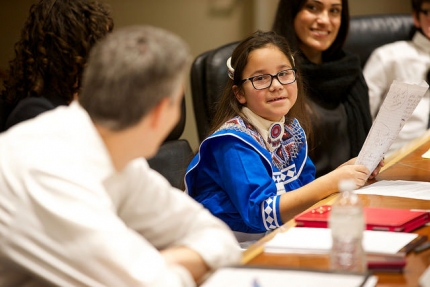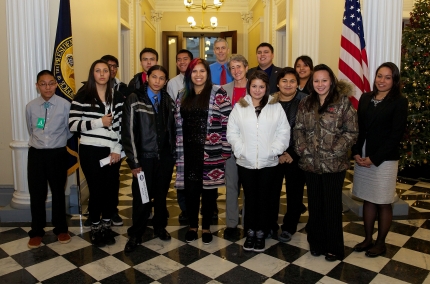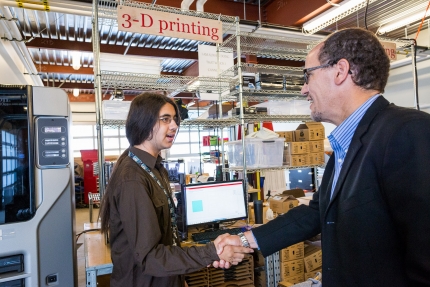Blog Posts Related to the Native American Community
Investing in the Future of Tribal Nations
Posted by on February 27, 2015 at 6:54 PM EDTAs part of his commitment to strengthening nation-to-nation relationships with Indian tribes, President Obama hosted his sixth White House Tribal Nations Conference in December 2014. The Conference built on the President’s trip to the Standing Rock Sioux Indian Reservation last summer, where he dedicated efforts to improve opportunities for Native youth and affirmed his promise to work together with tribes on education and economic development in Indian Country.
In addition to hosting the Conference, the White House released its 2014 White House Tribal Nations Conference Progress Report, Investing in the Future of Tribal Nations. The report highlights the Administration’s progress and accomplishments in Indian Country over the past year.
Learn more aboutYoung Native Americans Share School Culture Experiences with Secretary Duncan
Posted by on February 18, 2015 at 8:48 PM EDTEd. note: This is cross-posted on the U.S. Department of Education's blog. See the original post here.
While many students face challenges when it comes to growing up and pursuing academic success, Native American and Alaskan Native youths are more likely than most of their peers to experience poverty and trauma, and to drop out of high school. Their school environment has a significant role in their development.
This is just one of the reasons why ED recently invited 15 young Native Americans to attend a Student Voices Session with Secretary Duncan.
This session was also a capstone to ED’s first-ever School Environment Listening Tour, a nine-city tour in seven states designed to identify the impact of school environment on young Native Americans.
Learn more aboutAffordable Care Act: Enrollment Opportunity for American Indians and Alaska Natives
Posted by on February 13, 2015 at 8:09 PM EDTEd. note: This is cross-posted on the U.S. Department of Health and Human Services' blog. See the original post here.
The deadline to enroll in 2015 coverage through the Health Insurance Marketplaces is February 15. I urge all American Indians and Alaska Natives to go to HealthCare.gov, call 1-800-318-2596, or visit localhelp.healthcare.gov to see what benefits are available to you and to ensure that you have health coverage for 2015.
As an American Indian and Alaska Native, you may be eligible for services through the Indian Health Service (IHS), but the local facility may not be able to provide certain health care services, or you may live too far away to access those services. If you do not have other health insurance coverage, such as Medicare, Medicaid or CHIP, I encourage you to make sure you don’t miss the open enrollment deadline.
American Indians and Alaska Natives who are Tribal members can still enroll after February 15, but if not, your only chance to enroll to purchase health insurance coverage for 2015 is during the open enrollment period, which ends in two days!
If you are a member of a Tribe or are eligible for IHS, you can apply for an exemption from maintaining health coverage, but I hope you at least check to see what your benefits are under the Affordable Care Act before the enrollment deadline. You might find out that you can purchase a really great insurance plan for a very small monthly cost based on your income, and you might qualify for no out-of-pocket costs if you are a member of a federally-recognized Tribe.
Please don’t miss the deadline on February 15 and #GetCovered!
Yvette Roubideaux, M.D., M.P.H., is the Senior Advisor to the Secretary for American Indians and Alaska Natives.
Learn more aboutThe White House Launches the “Generation Indigenous Native Youth Challenge”
Posted by on February 12, 2015 at 7:32 PM EDTToday, Director of the White House Domestic Policy Council Cecilia Muñoz announced the launch of the Generation Indigenous Native Youth Challenge at the 2015 United National Indian Tribal Youth (UNITY) Midyear Conference. This challenge invites Native youth and organizations across the country to become a part of the Administration’s Generation Indigenous (Gen-I) initiative by joining the National Native Youth Network — a White House effort in partnership with the Aspen Institute’s Center for Native American Youth and the U.S. Department of the Interior.
President Obama launched the Gen-I Initiative at the 2014 White House Tribal Nations Conference to focus on improving the lives of Native youth by removing the barriers that stand between Native youth and their opportunity to succeed. Through new investments and increased engagement, this initiative takes a comprehensive, culturally appropriate approach to ensure all young Native people can reach their full potential.
In addition to the National Native Youth Network, the Gen-I Initiative includes a demonstration program called the Native Youth Community Projects, administered by the Department of Education, a restructuring of the Bureau of Indian Education, a Cabinet Native Youth Listening Tour, and the organization of the first ever White House Tribal Youth Gathering.
Also announced today was the signing of an agreement between UNITY, the Department of Justice’s Office of Juvenile Justice and Delinquency Prevention, and the White House, to collaborate on the first ever White House Tribal Youth Gathering that will take place this summer.
We encourage everyone to take the Gen-I Native Youth Challenge and become a part of the National Native Youth Network today!
Gen-I Native Youth Challenge
As part of the process of establishing the National Native Youth Network, we invite Native youth and all young people across the country to take part in the Gen-I Challenge. This call to action is the first step in engaging a broad network of people interested in addressing the issues facing Native youth and creating a platform through which Native youth can access information about opportunities and resources, and have their voices and positive contributions highlighted and elevated.
Here’s how it works: Youth 14-24, non-profits, and educational institutions are invited to join the National Native Youth Network by accepting the Gen-I Challenge.
Who: Individuals, youth councils, and youth groups can participate as Challenge Acceptors. Non-profit organizations, Colleges, Universities, and Tribal Colleges and Universities (TCU) can become acceptors by helping their youth and students complete the Gen-I Challenge!
Youth and others can accept the challenge by following this link and committing to take the following steps.
Step 1: ACT. Within 30 days of taking the challenge, youth should work with other youth in their community or at their school to do something positive of their choosing (for example: completing a volunteer project with a local organization or charity, hosting a meeting with other youth to brainstorm how to address an issue of concern in their community, or becoming a mentor to a younger person). The youth can use toolkits from the National Native Youth Network and their partners to help them achieve their goal. Their local tribal youth council, urban tribal youth group, or Native youth organization can also be a resource.
Step 2: CAPTURE. Youth should document their community efforts and projects through a short summary (3-4 sentences) with photos and video!
Step 3: SHARE. Youth should share their stories online using #GenI and send the National Native Youth Network their story through www.cnay.org/Challenge.html. The National Native Youth Network or the White House may even feature their story.
Step 4: PARTICIPATE. By participating in the National Native Youth Network, youth may be invited to apply to send a representative to the first ever White House Tribal Youth Gathering in Washington, D.C., in the summer of 2015.
Organizations, colleges, universities, and TCUs can take the Gen-I Challenge too by committing to help their youth and students complete the Gen-I Challenge! They just follow this link to get signed up.
The following organizations have already committed to take the Gen-I Challenge and get their youth onboard.
Gen-I Native Youth Challenge Early Acceptors
- American Indian College Fund
- American Indian Higher Education Consortium
- Boys and Girls Clubs of America
- Center for Native American Youth at the Aspen Institute
- Close Up Foundation
- National Congress of American Indians
- National Indian Child Welfare Association
- National Indian Education Association
- National Indian Health Board
- United National Indian Tribal Youth
Learn more aboutAffordable Care Act – National Tribal Day of Action
Posted by on February 2, 2015 at 7:33 PM EDTEd. note: This is cross-posted on the Indian Health Service's website. See the original post here.
Today is the 3rd National Tribal Day of Action for Affordable Care Act Outreach and Enrollment. Across the nation, IHS facilities are holding events today to provide American Indian and Alaska Natives with information and help in understanding the Affordable Care Act and their potential benefits in the Health Insurance Marketplace.
Open enrollment ends on February 15, 2015. That means there are less than two weeks left in the Marketplace Open Enrollment period, so now is the time to act. All Americans must have health coverage under the Affordable Care Act. If not, they must claim an exemption or may have to pay a penalty. If you are a tribal member, you can enroll anytime, but it is important to know what your potential benefits would be if you purchased insurance in the Health Insurance Marketplace. Enrolling is easy with the new streamlined application, and in-person help is always available at an IHS facility. You might also find out that you are newly eligible for Medicaid and you can enroll in Medicaid at any time. In addition, now that tax season is upon us, you can also file for an exemption when you file your taxes, even if you have coverage. Individuals who are tribal members and/or eligible for IHS services can claim an exemption.
You can always get care at IHS if you are eligible; but with health insurance, you will be covered, have more choices, and will be in the best position for your health. Once you are covered, it's easier to get care when and where you want it, and you can get peace of mind. Enroll in the Health Insurance Marketplace today at www.healthcare.gov.
Learn more about"Gen-I" Ambassadors Celebrated at White House Tribal Nations Conference and in MTV Rebel Music Film
Posted by on January 21, 2015 at 7:08 PM EDTOn December 3rd, President Obama hosted the 6th annual White House Tribal Nations conference where he announced Generation Indigenous (“Gen-I”), a new initiative focused on removing the barriers that stand between Native youth and their opportunity to succeed using a comprehensive, culturally appropriate approach. In addition to leaders from the 566 federally-recognized Native nations, for the first time, 37 high-school aged “Gen-I” Native Youth Ambassadors were invited to engage with the President, Vice President, and Cabinet Officials representing the White House Council on Native American Affairs on key issues facing tribes. The Conference built on the President’s visit to the Standing Rock Sioux Indian Reservation in June, during which he and First Lady Michelle Obama met with a group of Lakota young adults and learned about the obstacles and problems they had experienced resulting from substance abuse, violence and other poverty-related issues.
Through “Gen I”, the Youth Ambassadors represented the voice of Native youth at the Conference by joining with tribal leaders in breakout sessions and panels and participating in leadership development programming. Click here to learn more about Gen-I! The 2014 Youth Ambassadors came from across the country, from Alaska to North Carolina, and are an inspiring group with big plans for making a positive impact in their communities. Over the course of their trip to D.C., they participated in exciting events in advance of the Conference, including a White House screening of MTV’s riveting Rebel Music: Native America premiere episode followed by a panel discussion including Rebel Music creator Nusrat Durrani and Lakota rapper Frank Waln and a signing ceremony for a new MOU between the Indian Health Service and Nike N7, which included a visit with 2014 FIFA World Cup Kiowa soccer player Chris Wondolowski. Several of the Ambassadors were featured in a new MTV video “Meet Generation Indigenous” that followed two of the youth on their inspiring journey from their home communities to Washington, D.C.
Learn more aboutStudent Voices Session: Shining a Spotlight on Native Youth in Foster Care
Posted by on December 18, 2014 at 4:03 PM EDTEd. note: This is cross-posted on the U.S. Department of Education's blog. See the original post here.
Youth from every ethnicity and population group experience challenges. American Indian and Alaska Native youth in the foster care system often also must contend with a disconnection from their tribal communities and cultures.
On Dec. 8th, I attended a Student Voices session at the White House hosted by the Department of Education (ED) and Department of Interior. During this time, I witnessed the Obama Administration turn a corner on an issue that is too often invisible to the general public and politicians — understanding the plight of Native youth in foster care.
Fifteen current and former foster care youth representing American Indian and Alaska Native nations from across the United States sat down with Secretaries Arne Duncan and Sally Jewell at the event to discuss the unique struggles that Native youth face.
They all courageously shared stories of survival before entering foster care and of a heartbreaking desire to remain connected to their tribes when placed in foster homes far from their tribal communities. For me, their stories and my own share a key message — take us away from our homes and our culture, and you take us away from our identity and our drive to achieve.
Learn more about EducationWhen Tribes Compete, Tribes Can Succeed
Posted by on December 4, 2014 at 7:17 PM EDTEd. note: This was originally posted on the U.S. Department of Labor's blog yesterday. See the original post here.
When President Obama made his first trip to Indian Country earlier this year, he told a compelling story about the impact federal investment and partnerships have in tribal communities. So I was privileged today to participate in the President’s sixth White House Tribal Nations Conference. Because of the challenges tribal communities continue to face with high rates of unemployment and barriers to opportunity, the conference was an important chance to discuss the Department of Labor and Administration’s efforts to create shared prosperity in Indian Country – and to hear from tribal leaders directly about their ideas for expanding and improving our work.
- &lsaquo previous
- 1
- 2
- 3
- 4
- 5
- 6
- 7
- 8
- 9
- …
- next &rsaquo


